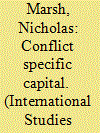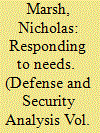| Srl | Item |
| 1 |
ID:
076497


|
|
|
|
|
| Publication |
2007.
|
| Summary/Abstract |
This article presents a correspondence between the mode of weapons acquisition by armed opposition groups and the form of a civil war. The mode of arms acquisition is affected by two factors-availability and control over the acquisition process. Variations in the mode of arms acquisition correspond to three types of insurgency: led by a single and organized group, warlordism, and disorganized armed bands. This article discusses how weapons acquisition is considered in the existing literature on arms and civil conflict, and examines the definitions of arms availability. It provides new insights on the availability and control of weapons in civil conflict and provides examples from Nepal, Iraq, and Afghanistan. The article concludes with an examination of the policy implications of its findings.
|
|
|
|
|
|
|
|
|
|
|
|
|
|
|
|
| 2 |
ID:
137417


|
|
|
|
|
| Summary/Abstract |
The 2011 Libyan civil war prompted a reassessment of the normative foundation of the EU's conventional arms export control regime as armaments manufactured in Europe were used by Gaddafi's forces during the war. The EU's foreign policy identity is based, partly, upon a common approach to arms export involving respect for common criteria for export licences. Yet, prior to the civil war, considerable amounts of military equipment had been exported by member states to Libya, notwithstanding grounds for restraint on the basis of several of the criteria. This article traces member states' arms export to Libya during 2005–2010 to explore whether member states favoured restraint or export promotion. It concludes that although aware of the risks of exporting, in a competitive market for military goods, member states sought commercial advantage over restraint, and comprehensively violated export control principles. This casts doubts on assertions of the EU acting as a “normative power”.
|
|
|
|
|
|
|
|
|
|
|
|
|
|
|
|
| 3 |
ID:
192614


|
|
|
|
|
| Summary/Abstract |
The article analyses the provision of military aid to Ukraine during the first year after the 2022 Russian invasion and explains why it was more effective compared to other examples. It discusses the impact of material and intangible military assistance. The article examines tensions arising from principal-agent relationships between Ukraine and the states that provided support that may have affected what was provided and when it was delivered. It is notable that providers of assistance emphasised equipment rather than training, a choice that could be made because Ukraine had already built up a high level of combat skills and military organisation. The article argues that the distinctive aspects of military assistance to Ukraine that led to its impact were the quality and quantity of equipment provided, good communication and co-ordination between Ukraine and those states providing assistance, and that Ukrainian defence and government institutions could manage the aid provided.
|
|
|
|
|
|
|
|
|
|
|
|
|
|
|
|